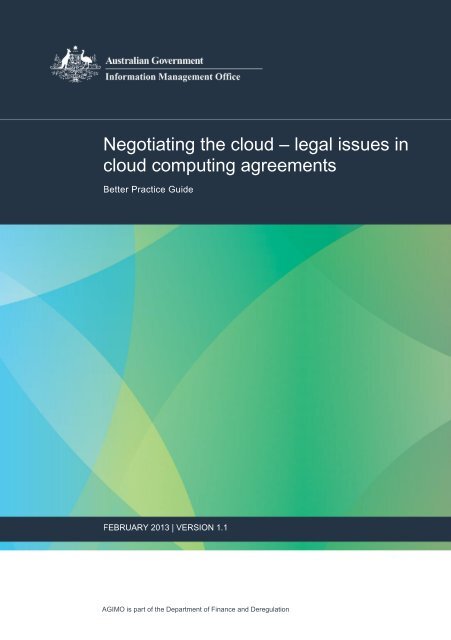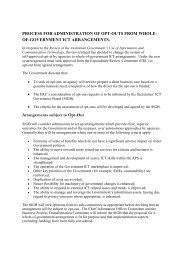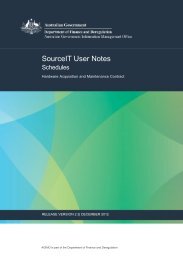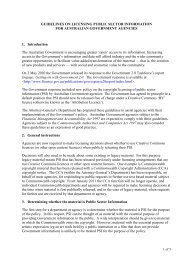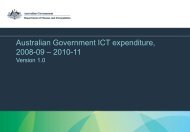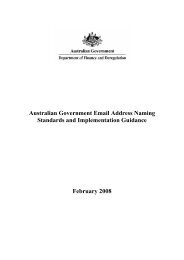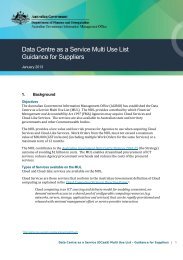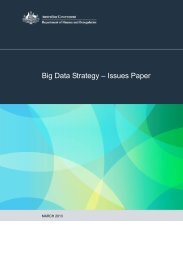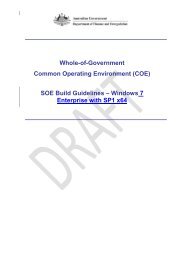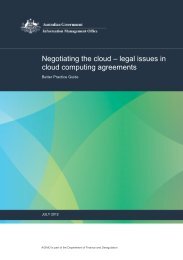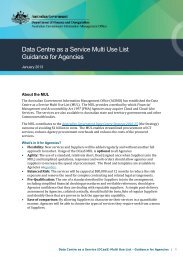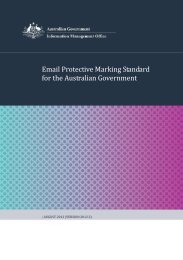legal issues in cloud computing agreements - Australian ...
legal issues in cloud computing agreements - Australian ...
legal issues in cloud computing agreements - Australian ...
Create successful ePaper yourself
Turn your PDF publications into a flip-book with our unique Google optimized e-Paper software.
Negotiat<strong>in</strong>g the <strong>cloud</strong> – <strong>legal</strong> <strong>issues</strong> <strong>in</strong><br />
<strong>cloud</strong> comput<strong>in</strong>g <strong>agreements</strong><br />
Better Practice Guide<br />
FEBRUARY 2013 | VERSION 1.1<br />
AGIMO is part of the Department of F<strong>in</strong>ance and Deregulation
Contents<br />
Contents 2<br />
Version Control 3<br />
Introduction 4<br />
Overview of <strong>cloud</strong> comput<strong>in</strong>g <strong>legal</strong> <strong>issues</strong> 4<br />
What is <strong>cloud</strong> comput<strong>in</strong>g 4<br />
Deployment models 5<br />
Obta<strong>in</strong><strong>in</strong>g <strong>cloud</strong> comput<strong>in</strong>g services 5<br />
How to use this guide 6<br />
Key <strong>legal</strong> <strong>issues</strong> 7<br />
Protection of <strong>in</strong>formation 7<br />
Liability 11<br />
Performance management 12<br />
End<strong>in</strong>g the arrangement 14<br />
Dispute resolution 15<br />
Other <strong>legal</strong> <strong>issues</strong> 16<br />
Manag<strong>in</strong>g the agreement 18<br />
Further <strong>in</strong>formation 19<br />
Cloud comput<strong>in</strong>g policy guidance 19<br />
General <strong>legal</strong> guidance 19<br />
Legal checklist 20<br />
Acknowledgments 21<br />
Disclaimer 21<br />
Copyright notice 21<br />
AGIMO is part of the Department of F<strong>in</strong>ance and Deregulation
Version Control<br />
Date Version Changes<br />
July 2012 1.0 Orig<strong>in</strong>al<br />
February 2013 1.1 M<strong>in</strong>or updates<br />
AGIMO is part of the Department of F<strong>in</strong>ance and Deregulation
Introduction<br />
Like <strong>cloud</strong> comput<strong>in</strong>g itself, <strong>cloud</strong> comput<strong>in</strong>g <strong>agreements</strong> appear <strong>in</strong> a wide variety of forms.<br />
These can range from simple standardised click wrap <strong>agreements</strong> to multilayered sets of terms<br />
and conditions. There are, however, a core set of <strong>legal</strong> <strong>issues</strong> that agencies should consider <strong>in</strong><br />
any <strong>cloud</strong> comput<strong>in</strong>g agreement, whether the agreement expressly deals with those <strong>issues</strong> or<br />
not.<br />
The purpose of this Better Practice Guide is to assist agencies to navigate typical <strong>legal</strong> <strong>issues</strong> <strong>in</strong><br />
<strong>cloud</strong> comput<strong>in</strong>g <strong>agreements</strong>. Some of these <strong>issues</strong> will be familiar to those who deal regularly<br />
with <strong>in</strong>formation technology contracts, but even <strong>in</strong> respect to those <strong>issues</strong>, the nature of <strong>cloud</strong><br />
comput<strong>in</strong>g can create new or different risks and agencies may need to consider those <strong>issues</strong><br />
afresh <strong>in</strong> the <strong>cloud</strong> comput<strong>in</strong>g context.<br />
Overview of <strong>cloud</strong> comput<strong>in</strong>g <strong>legal</strong> <strong>issues</strong><br />
What is <strong>cloud</strong> comput<strong>in</strong>g<br />
As set out <strong>in</strong> the Cloud Comput<strong>in</strong>g Strategic Direction Paper 1 , the <strong>Australian</strong> Government def<strong>in</strong>es<br />
<strong>cloud</strong> comput<strong>in</strong>g as:<br />
an ICT sourc<strong>in</strong>g and delivery model for enabl<strong>in</strong>g convenient, on-demand network access to a<br />
shared pool of configurable comput<strong>in</strong>g resources (e.g. networks, servers, storage, applications<br />
and services) that can be rapidly provisioned and released with m<strong>in</strong>imal management effort<br />
or service provider <strong>in</strong>teraction.<br />
Cloud comput<strong>in</strong>g at the broadest level, therefore, is the provision of comput<strong>in</strong>g as a service over<br />
a network, typically the Internet.<br />
Cloud comput<strong>in</strong>g services are usually grouped <strong>in</strong>to the follow<strong>in</strong>g categories:<br />
<br />
<br />
<br />
software as a service – the provision of software over a network rather than the software<br />
be<strong>in</strong>g loaded directly onto a locally available computer<br />
platform as a service – the provision of comput<strong>in</strong>g platforms that create the environment for<br />
other software to run (for example, operat<strong>in</strong>g systems) over a network rather than be<strong>in</strong>g<br />
loaded directly onto a locally available computer<br />
<strong>in</strong>frastructure as a service – the provision of access to computer <strong>in</strong>frastructure (for example,<br />
data storage or process<strong>in</strong>g capability) over a network that is used to compliment local<br />
platform resources.<br />
1<br />
http://agimo.gov.au/files/2012/04/f<strong>in</strong>al_<strong>cloud</strong>_comput<strong>in</strong>g_strategy_version_1.pdf<br />
Negotiat<strong>in</strong>g the <strong>cloud</strong> – <strong>legal</strong> <strong>issues</strong> <strong>in</strong> <strong>cloud</strong> comput<strong>in</strong>g <strong>agreements</strong> | 4
Cloud comput<strong>in</strong>g is becom<strong>in</strong>g an <strong>in</strong>creas<strong>in</strong>gly attractive model for delivery of an ever expand<strong>in</strong>g<br />
range of hardware and software functionality, primarily due to the potential cost sav<strong>in</strong>gs and<br />
enhanced flexibility that can be offered by <strong>cloud</strong> comput<strong>in</strong>g providers.<br />
Cost sav<strong>in</strong>gs can potentially be achieved as a result of the aggregation of hardware <strong>in</strong> large data<br />
centres and the ability of such centres to offer on-demand comput<strong>in</strong>g to cater for peaks and<br />
troughs <strong>in</strong> an agency's comput<strong>in</strong>g usage. Enhanced flexibility arises from the ability for users to<br />
access comput<strong>in</strong>g from a range of locations (courtesy of the Internet). This flexibility is bolstered<br />
by the <strong>in</strong>creas<strong>in</strong>g spread of wireless Internet connectivity and the proliferation of mobile<br />
Internet enabled devices that make mobile comput<strong>in</strong>g more attractive and accessible.<br />
Deployment models<br />
Cloud comput<strong>in</strong>g can be deployed <strong>in</strong> a number of ways <strong>in</strong>clud<strong>in</strong>g:<br />
<br />
<br />
<br />
<br />
public <strong>cloud</strong> (where access to the <strong>cloud</strong> comput<strong>in</strong>g service is not restricted to a particular<br />
entity or community of entities and is generally available to the public)<br />
private <strong>cloud</strong> (where access is restricted to a s<strong>in</strong>gle private entity – for example a s<strong>in</strong>gle<br />
agency)<br />
community <strong>cloud</strong> (where access is available for a community of entities – for example, a<br />
range of <strong>Australian</strong> Government agencies <strong>in</strong> a government community <strong>cloud</strong>)<br />
hybrid <strong>cloud</strong> (where more than one of the above models operate <strong>in</strong> tandem to provide some<br />
level of <strong>in</strong>teractivity between the <strong>cloud</strong>s that is not available outside of the hybrid <strong>cloud</strong>).<br />
Obta<strong>in</strong><strong>in</strong>g <strong>cloud</strong> comput<strong>in</strong>g services<br />
In the Commonwealth policy context, the process of obta<strong>in</strong><strong>in</strong>g <strong>cloud</strong> comput<strong>in</strong>g services would<br />
normally be classified as a procurement. As a result it will be necessary for an agency to meet all<br />
the usual requirements that apply to procurement, <strong>in</strong>clud<strong>in</strong>g compliance with:<br />
<br />
the Commonwealth Procurement Rules 2 (CPRs)<br />
and, for FMA Act agencies:<br />
the agency's Chief Executive Instructions 3<br />
the F<strong>in</strong>ancial Management and Accountability 4 (FMA) process.<br />
In many cases, and particularly for large-scale <strong>cloud</strong> comput<strong>in</strong>g services, the Additional Rules of<br />
the CPRs 5 are likely to be triggered. This means that <strong>cloud</strong> comput<strong>in</strong>g services will generally<br />
need to be obta<strong>in</strong>ed as the result of an open approach to the market and consequent evaluation<br />
process to select a preferred tenderer (or panel of providers).<br />
The <strong>Australian</strong> Government established the Data Centre as a Service Multi Use List 6 (DCaaS<br />
MUL) <strong>in</strong> October 2012. The DCaaS MUL provides agencies with a simple way to procure Cloud<br />
and Cloud-Like services under contracts up to $80,000 (<strong>in</strong>c GST) over a term of up to 12 months.<br />
2<br />
3<br />
4<br />
5<br />
6<br />
http://www.f<strong>in</strong>ance.gov.au/procurement/procurement-policy-and-guidance/commonwealth-procurement-rules/<strong>in</strong>dex.html<br />
Model CEI's are available at http://www.f<strong>in</strong>ance.gov.au/publications/f<strong>in</strong>ance-circulars/2011/ceis.html<br />
http://www.f<strong>in</strong>ance.gov.au/f<strong>in</strong>ancial-framework/fma-legislation/fma-agencies.html<br />
http://www.f<strong>in</strong>ance.gov.au/procurement/procurement-policy-and-guidance/commonwealth-procurement-rules/cprs-additional-rulesfor-procurements.html<br />
http://agimo.gov.au/policy-guides-procurement/data-centres/data-centre-as-a-service-dcaas-multi-use-list-mul-fact-sheet/<br />
Negotiat<strong>in</strong>g the <strong>cloud</strong> – <strong>legal</strong> <strong>issues</strong> <strong>in</strong> <strong>cloud</strong> comput<strong>in</strong>g <strong>agreements</strong> | 5
Agencies should monitor the AGIMO blog 7 for further <strong>in</strong>formation relat<strong>in</strong>g to Whole-of-<br />
Government <strong>cloud</strong> procurement approaches.<br />
How to use this guide<br />
In some cases – for example where the services are offered only by one provider because of the<br />
need for particular proprietary software or hardware – agencies may have to deal with the <strong>legal</strong><br />
<strong>agreements</strong> proposed by the provider. In other cases, agencies may be able to propose their own<br />
<strong>legal</strong> terms. In either situation, agencies should carefully consider the implications of the terms<br />
of the proposed agreement. This guide sets out some of these considerations.<br />
In us<strong>in</strong>g the guide, agencies should be aware that:<br />
<br />
<br />
This guide canvasses typical <strong>issues</strong> <strong>in</strong> <strong>cloud</strong> comput<strong>in</strong>g <strong>legal</strong> <strong>agreements</strong> but other<br />
significant <strong>issues</strong> may exist <strong>in</strong> a specific agreement. Agencies should therefore always<br />
carefully review and obta<strong>in</strong> all necessary <strong>legal</strong> advice on the specific terms to use.<br />
Not all of the <strong>legal</strong> <strong>issues</strong> raised <strong>in</strong> this guide will be relevant to each <strong>cloud</strong> comput<strong>in</strong>g<br />
service. For example, some <strong>issues</strong> relat<strong>in</strong>g to the protection of <strong>in</strong>formation may be less<br />
important where the provider is not hold<strong>in</strong>g or access<strong>in</strong>g the agency’s data.<br />
The standard terms on which many <strong>cloud</strong> comput<strong>in</strong>g services are offered may not meet all of the<br />
<strong>legal</strong> requirements of an agency. As those requirements may impact on the price and delivery<br />
model for <strong>cloud</strong> comput<strong>in</strong>g services, it is important for an agency to raise the relevant <strong>issues</strong> and<br />
contractual positions (such as those set out <strong>in</strong> this guide) with providers early <strong>in</strong> the<br />
procurement process. This will assist the agency to negotiate an agreement that is acceptable to<br />
all parties.<br />
The key <strong>legal</strong> <strong>issues</strong> addressed by this guide can be broken down <strong>in</strong>to the follow<strong>in</strong>g categories:<br />
<br />
<br />
<br />
<br />
<br />
<br />
protection of <strong>in</strong>formation<br />
liability<br />
performance management<br />
end<strong>in</strong>g the arrangement<br />
dispute resolution<br />
other <strong>legal</strong> <strong>issues</strong>.<br />
This guide also looks at the longer term <strong>issues</strong> associated with manag<strong>in</strong>g a <strong>cloud</strong> comput<strong>in</strong>g<br />
agreement over its life.<br />
7<br />
http://agimo.gov.au/blog/<br />
Negotiat<strong>in</strong>g the <strong>cloud</strong> – <strong>legal</strong> <strong>issues</strong> <strong>in</strong> <strong>cloud</strong> comput<strong>in</strong>g <strong>agreements</strong> | 6
Key <strong>legal</strong> <strong>issues</strong><br />
Protection of <strong>in</strong>formation<br />
Privacy<br />
Information about the privacy obligations for Commonwealth contracts can be found on the<br />
Office of the <strong>Australian</strong> Information Commissioner’s (OAIC) website 8 . Agencies are also strongly<br />
advised to consider the Better Practice Guide – Privacy and Cloud Comput<strong>in</strong>g for <strong>Australian</strong><br />
Government Agencies 9 before enter<strong>in</strong>g <strong>in</strong>to any <strong>cloud</strong> comput<strong>in</strong>g arrangement.<br />
Cloud comput<strong>in</strong>g does not necessarily have to be privacy <strong>in</strong>vasive, but mov<strong>in</strong>g data <strong>in</strong>to the<br />
<strong>cloud</strong> means that the data will move outside of the direct control of the agency and may, <strong>in</strong> some<br />
<strong>in</strong>stances, be processed and stored outside of Australia. Different levels of <strong>in</strong>direct control of this<br />
data are possible depend<strong>in</strong>g on the type of <strong>cloud</strong> service selected and the <strong>legal</strong> protections put <strong>in</strong><br />
place by the agency.<br />
Agencies need to be aware of their privacy and data security obligations when transferr<strong>in</strong>g<br />
personal <strong>in</strong>formation <strong>in</strong>to any <strong>cloud</strong> environment. If privacy <strong>issues</strong> cannot be adequately<br />
addressed, the OAIC advises that it will not be appropriate to transfer 'personal <strong>in</strong>formation'<br />
<strong>in</strong>to a public <strong>cloud</strong>.<br />
Section 95B of the Privacy Act 1988 10 requires agencies enter<strong>in</strong>g <strong>in</strong>to contracts for the provision<br />
of services to the Commonwealth, to:<br />
<br />
<br />
take contractual measures to ensure contracted services providers do not do an act or<br />
engage <strong>in</strong> a practice that would breach any Information Privacy Pr<strong>in</strong>ciples (IPPs) 11<br />
ensure <strong>agreements</strong> do not authorise providers or their subcontractors to do or engage <strong>in</strong> an<br />
act or practice that would breach any IPPs,<br />
if done or engaged <strong>in</strong> by the agency itself.<br />
In addition, agencies should ensure that the provider is contractually prohibited from us<strong>in</strong>g the<br />
data for any of the provider’s own purposes – such as advertis<strong>in</strong>g or other commercial services –<br />
as this is likely to be <strong>in</strong>consistent with the IPPs and the <strong>in</strong>tentions of the agency <strong>in</strong> enter<strong>in</strong>g the<br />
agreement.<br />
Agencies engag<strong>in</strong>g <strong>cloud</strong> service providers need to take appropriate contractual measures to<br />
ensure personal <strong>in</strong>formation is protected, regardless of whether or not the provider (and any<br />
subcontractors) are based <strong>in</strong> Australia or overseas. When contract<strong>in</strong>g offshore, agencies need to<br />
take particular care to ensure they are able to enforce the provisions of the agreement.<br />
8<br />
9<br />
10<br />
11<br />
http://www.oaic.gov.au/<br />
http://agimo.gov.au/files/2012/04/privacy_and_<strong>cloud</strong>_comput<strong>in</strong>g_for_australian_government_agencies.pdf<br />
http://www.comlaw.gov.au/Details/F2008B00225/Download<br />
http://www.privacy.gov.au/materials/types/<strong>in</strong>fosheets/view/6541<br />
Negotiat<strong>in</strong>g the <strong>cloud</strong> – <strong>legal</strong> <strong>issues</strong> <strong>in</strong> <strong>cloud</strong> comput<strong>in</strong>g <strong>agreements</strong> | 7
Agencies should also consider the practical implications of their Privacy Act obligations,<br />
<strong>in</strong>clud<strong>in</strong>g whether specific contractual measures enabl<strong>in</strong>g them to meet their obligations are<br />
required. For example, IPP 7 Alteration of records conta<strong>in</strong><strong>in</strong>g personal <strong>in</strong>formation requires<br />
agencies, where an <strong>in</strong>dividual’s request to alter a record has been refused, to attach a statement<br />
to the record on request. Agencies would need to ensure that a <strong>cloud</strong> service provider is obliged<br />
to meet this requirement.<br />
Future privacy compliance<br />
From March 2014, 13 new <strong>Australian</strong> Privacy Pr<strong>in</strong>ciples (APP’s) will apply to both the public and<br />
private sector. For <strong>Australian</strong> Government agencies these APP's will replace the current IPP's.<br />
The APP's are structured to reflect the <strong>in</strong>formation life cycle from notification and collection,<br />
through to use and disclosure, security, access and correction.<br />
While the changes to the Privacy Act will not take effect until March 2014, agencies should start<br />
prepar<strong>in</strong>g now to ensure compliance with the new APP's. This may <strong>in</strong>clude consider<strong>in</strong>g the<br />
impact of the APPs <strong>in</strong> any <strong>cloud</strong> comput<strong>in</strong>g procurements agencies anticipate undertak<strong>in</strong>g.<br />
The OAIC will produce detailed guidance published on the OAIC website 12 to assist agencies to<br />
understand the impact of the reforms and make the necessary changes to agency <strong>in</strong>formation<br />
handl<strong>in</strong>g practices.<br />
Security<br />
Clearly one significant issue for any <strong>cloud</strong> comput<strong>in</strong>g agreement where the provider holds, or is<br />
able to access, an agency's data is the security of that data. This issue is heightened from a risk<br />
perspective where the data is sensitive (<strong>in</strong>clud<strong>in</strong>g personal <strong>in</strong>formation).<br />
Agencies should refer to the Defence Signals Directorate's Cloud Comput<strong>in</strong>g Security<br />
Considerations 13 for detailed guidance on <strong>issues</strong> to consider from a security perspective. In<br />
follow<strong>in</strong>g this guidance, agencies should develop a comprehensive risk assessment to make an<br />
<strong>in</strong>formed decision on the suitability of adopt<strong>in</strong>g a <strong>cloud</strong> based solution and assess the<br />
appropriate security protections it requires. The follow<strong>in</strong>g are contractual measures that may,<br />
depend<strong>in</strong>g on the circumstances <strong>in</strong>clud<strong>in</strong>g the type of <strong>cloud</strong> service used, be appropriate to<br />
<strong>in</strong>clude <strong>in</strong> an agreement for <strong>cloud</strong> comput<strong>in</strong>g services:<br />
<br />
<br />
<br />
<br />
where the service is to be provided from a location with<strong>in</strong> Australia, a prohibition on the<br />
provider transmitt<strong>in</strong>g data outside of Australia without the prior approval of the agency<br />
the level of security and encryption to be applied to agency data held and transmitted by the<br />
provider<br />
the level of access security protocols to be implemented by the provider to defeat<br />
unauthorised attempts to access the data by third parties, provider personnel and other<br />
customers of the provider<br />
where physical media is damaged and replaced, requirements for the sanitisation or deletion<br />
of data <strong>in</strong> the damaged media<br />
12<br />
13<br />
http://www.oaic.gov.au/<br />
http://www.dsd.gov.au/<strong>in</strong>fosec/<strong>cloud</strong>security.htm<br />
Negotiat<strong>in</strong>g the <strong>cloud</strong> – <strong>legal</strong> <strong>issues</strong> <strong>in</strong> <strong>cloud</strong> comput<strong>in</strong>g <strong>agreements</strong> | 8
the storage of separate packages of data – for example, it may be important to avoid the<br />
provider aggregat<strong>in</strong>g separate packages on the same hardware (as such aggregation may<br />
<strong>in</strong>crease the sensitivity of data or risks to security of the <strong>in</strong>formation)<br />
a requirement for the provider to notify the agency immediately <strong>in</strong> the event of security<br />
<strong>in</strong>cidents or <strong>in</strong>trusions, or requests from foreign government agencies for access to the data,<br />
to enable the agency to manage these events proactively<br />
a requirement for the provider to store data so as to prevent other customers of the provider<br />
from access<strong>in</strong>g the agency's data. For less sensitive data, logical separation supported by<br />
strong technical security measures (where data may be held on the same servers as other<br />
customer data) may be sufficient. If the data is more sensitive, storage on specified hardware<br />
that is unique to the agency may be appropriate so that there can be physical security<br />
precautions set up between the hardware stor<strong>in</strong>g the agency's <strong>in</strong>formation and other<br />
hardware held by the provider<br />
a requirement for the provider to destroy or sanitise (or de-identify <strong>in</strong> the case of personal<br />
<strong>in</strong>formation) sensitive <strong>in</strong>formation held by the provider at the end of the agreement, where<br />
such data is not or cannot be returned to the agency. This may need to extend to destruction<br />
of physical hardware on which such data is held to avoid risk that the data may be recovered<br />
specific security requirements depend<strong>in</strong>g on the nature of the service and the sensitivity of<br />
the data.<br />
Confidentiality<br />
An agency may have contractual, equitable or statutory obligations to keep particular<br />
<strong>in</strong>formation confidential. Therefore it is important that these obligations are also transmitted to<br />
the provider <strong>in</strong> circumstances where the provider is stor<strong>in</strong>g or access<strong>in</strong>g an agency's data.<br />
In most cases, an agency will want a provider to meet a m<strong>in</strong>imum level of confidentiality for the<br />
agency’s <strong>in</strong>formation. In cases where the provider is obta<strong>in</strong><strong>in</strong>g access to particularly sensitive<br />
<strong>in</strong>formation, the level of protection will need to be significantly stronger. Agencies should<br />
consider <strong>in</strong> an agreement:<br />
<br />
<br />
<br />
the replication of any obligations placed upon the agency by contract or law<br />
for non-sensitive data, requirements to ensure the provider is aware of the level of<br />
confidentiality required and commits to protect<strong>in</strong>g that data appropriately<br />
for sensitive data, more detailed confidentiality obligations. In some cases where an extra<br />
layer of protection is necessary, it may be appropriate to:<br />
• require the provider to obta<strong>in</strong> <strong>in</strong>dividual confidentiality deeds from their personnel<br />
• restrict access to the agency’s data to a limited set of the provider’s personnel only.<br />
Where an agreement requires an agency to ma<strong>in</strong>ta<strong>in</strong> provider <strong>in</strong>formation as confidential,<br />
agencies should be aware of Commonwealth policies which require:<br />
<br />
<br />
restrict<strong>in</strong>g the type of provider <strong>in</strong>formation that is subject to confidentiality<br />
the <strong>in</strong>clusion of standard Commonwealth exceptions to confidentiality <strong>in</strong>clud<strong>in</strong>g the right to<br />
provide <strong>in</strong>formation to the relevant m<strong>in</strong>ister as well as houses of Parliament.<br />
Negotiat<strong>in</strong>g the <strong>cloud</strong> – <strong>legal</strong> <strong>issues</strong> <strong>in</strong> <strong>cloud</strong> comput<strong>in</strong>g <strong>agreements</strong> | 9
Records management requirements<br />
Agencies should refer to Records management and the <strong>cloud</strong> - a checklist 14 prepared by the<br />
National Archives of Australia for records management considerations <strong>in</strong> <strong>cloud</strong> comput<strong>in</strong>g. That<br />
advice requires agencies to <strong>in</strong>clude appropriate controls and protections (for example through<br />
agreement with the <strong>cloud</strong> service provider) that match the value of the records and address the<br />
risks of <strong>cloud</strong> comput<strong>in</strong>g for an agency’s records.<br />
Audit<br />
All the protections described <strong>in</strong> this section may potentially be worthless unless the agency is<br />
able to confirm that required <strong>in</strong>formation protection requirements are <strong>in</strong> fact be<strong>in</strong>g met. Audit of<br />
<strong>cloud</strong> comput<strong>in</strong>g arrangements is one way of check<strong>in</strong>g compliance. Audit of such arrangements<br />
is however potentially complicated by:<br />
<br />
<br />
the location of the data – which, unless specifically identified and locked down <strong>in</strong> the<br />
agreement, may be unknown to the agency, and could be located <strong>in</strong> one or more discrete<br />
sites <strong>in</strong> foreign countries<br />
the nature of <strong>cloud</strong> comput<strong>in</strong>g itself which may <strong>in</strong>volve agency data be<strong>in</strong>g spread across a<br />
large number of different provider comput<strong>in</strong>g devices (<strong>in</strong> order to harness the economies of<br />
scale and on-demand provision of comput<strong>in</strong>g that <strong>cloud</strong> comput<strong>in</strong>g services offer).<br />
As a result, agencies should consider <strong>in</strong>clud<strong>in</strong>g the follow<strong>in</strong>g rights <strong>in</strong> any agreement:<br />
restrict<strong>in</strong>g the locations/countries <strong>in</strong> which agency data may be held (with movement to<br />
new locations permitted with advance approval <strong>in</strong> writ<strong>in</strong>g from the agency)<br />
rights to audit the provider’s compliance with the agreement <strong>in</strong>clud<strong>in</strong>g rights of access to the<br />
provider’s premises where relevant records and agency data is be<strong>in</strong>g held<br />
audit rights for the agency (or its nom<strong>in</strong>ee), the Auditor-General and the Information<br />
Commissioner<br />
a right for the agency to appo<strong>in</strong>t a commercial auditor as its nom<strong>in</strong>ee (as this allows the<br />
agency to appo<strong>in</strong>t an auditor <strong>in</strong> the same location as the provider’s data centre to save costs<br />
and ensure compliance with relevant jurisdictional laws)<br />
where technically available, the right for the agency to remotely monitor access to its data<br />
and where this is not possible, a requirement that the provider ma<strong>in</strong>ta<strong>in</strong> an audit log of<br />
access to the agency's data and provide that log to the agency on request.<br />
Compensation for data loss/misuse<br />
It is possible that data could be permanently lost by a <strong>cloud</strong> comput<strong>in</strong>g services provider <strong>in</strong> a<br />
number of circumstances such as technical or operator error as well as fire or other disasters.<br />
Similarly, there is always the risk of misuse of data by rogue employees of the provider or<br />
compromise by external parties.<br />
While the probability of such problems can be m<strong>in</strong>imised by the provider ensur<strong>in</strong>g offsite data<br />
back-up, proper technical and security tra<strong>in</strong><strong>in</strong>g and hardware ma<strong>in</strong>tenance, it is important for<br />
an agency to consider how to address data loss or misuse <strong>in</strong> its agreement with the provider.<br />
This is particularly the case where the data is provided by third parties (such as members of the<br />
14<br />
http://www.naa.gov.au/Images/Cloud_checklist_with_logo_and_cc_licence_tcm16-44279.pdf<br />
Negotiat<strong>in</strong>g the <strong>cloud</strong> – <strong>legal</strong> <strong>issues</strong> <strong>in</strong> <strong>cloud</strong> comput<strong>in</strong>g <strong>agreements</strong> | 10
public) and the agency risks <strong>legal</strong> liability <strong>in</strong> the event data is unrecoverable or used<br />
<strong>in</strong>appropriately.<br />
An agency, <strong>in</strong> determ<strong>in</strong><strong>in</strong>g the risks posed by a <strong>cloud</strong> comput<strong>in</strong>g arrangement, should consider<br />
which party is best placed to manage those risks and therefore whether the agreement with the<br />
<strong>cloud</strong> service provider should:<br />
<br />
<br />
<br />
require the provider to be responsible for <strong>in</strong>direct and consequential losses (which will<br />
typically be the type of losses that flow from data loss and misuse)<br />
<strong>in</strong>clude an <strong>in</strong>demnity from the provider <strong>in</strong> respect to data loss or misuse as a result of the<br />
negligent, il<strong>legal</strong> or wilfully wrong act or omission of the provider or its personnel<br />
have a separate liability cap for data loss or misuse that is sufficiently high to cover potential<br />
liability aris<strong>in</strong>g from such loss or misuse.<br />
For more detail on the above terms, refer to the Liability section of this guide.<br />
Subcontractors<br />
A critical component of ensur<strong>in</strong>g that an agency has proper protection for its <strong>in</strong>formation is to<br />
ensure, <strong>in</strong> the agreement with the provider, that any subcontractors of the provider are also<br />
obliged to meet the same requirements as the provider. If this is not done, an agency may f<strong>in</strong>d<br />
that any protections it has negotiated <strong>in</strong>to the agreement with the provider do not end up giv<strong>in</strong>g<br />
it the desired protection where the services are carried out by subcontractors. It will also be<br />
important to know who a provider’s subcontractors are so that an agency understands what<br />
companies may have access to the agency’s systems and data.<br />
Liability<br />
Limitations on liability<br />
In common with traditional <strong>in</strong>formation technology <strong>agreements</strong>, <strong>cloud</strong> service <strong>agreements</strong><br />
typically seek to m<strong>in</strong>imise the provider's liability for any loss that arises from the provision of<br />
the service. This may <strong>in</strong>clude:<br />
<br />
<br />
<br />
exclud<strong>in</strong>g <strong>in</strong>direct and consequential losses (such as data loss)<br />
sett<strong>in</strong>g low liability caps (typically equivalent to one year’s fees under the agreement) or <strong>in</strong><br />
some cases exclud<strong>in</strong>g liability entirely<br />
not exclud<strong>in</strong>g key types of liability from any liability cap.<br />
Agencies should seek to comply with the Commonwealth's policy on capp<strong>in</strong>g supplier liability <strong>in</strong><br />
<strong>in</strong>formation technology contracts (see F<strong>in</strong>ance Circular 2006/03 15 ) when negotiat<strong>in</strong>g limitations<br />
with providers. The start<strong>in</strong>g po<strong>in</strong>t is that the Commonwealth will accept a cap on the provider's<br />
liability as a default position <strong>in</strong> <strong>in</strong>formation technology contracts provided that a list of<br />
exceptions to the cap is agreed by the provider. These exceptions are:<br />
<br />
<br />
<br />
personal <strong>in</strong>jury (<strong>in</strong>clud<strong>in</strong>g sickness and death)<br />
loss or damage to tangible property<br />
breach of privacy, security or confidentiality obligations<br />
15<br />
http://www.f<strong>in</strong>ance.gov.au/publications/f<strong>in</strong>ance-circulars/2006/03.html<br />
Negotiat<strong>in</strong>g the <strong>cloud</strong> – <strong>legal</strong> <strong>issues</strong> <strong>in</strong> <strong>cloud</strong> comput<strong>in</strong>g <strong>agreements</strong> | 11
<strong>in</strong>tellectual property <strong>in</strong>fr<strong>in</strong>gement<br />
unlawful, or il<strong>legal</strong>, acts or omissions.<br />
In addition to the standard exceptions, agencies should consider whether the risks of their<br />
procurement justify additional protection such as <strong>in</strong>clud<strong>in</strong>g the follow<strong>in</strong>g as exceptions to a<br />
provider's liability cap:<br />
<br />
<br />
<br />
loss caused by service <strong>in</strong>terruption<br />
data loss<br />
misuse of data.<br />
Decisions made by agencies about the amount of any liability cap should be <strong>in</strong>formed by a risk<br />
assessment that exam<strong>in</strong>es all identifiable potential liabilities and determ<strong>in</strong>es the likelihood and<br />
effect of such risks be<strong>in</strong>g realised.<br />
Indemnity<br />
An <strong>in</strong>demnity is a <strong>legal</strong>ly b<strong>in</strong>d<strong>in</strong>g promise by which one party undertakes to accept the risk of<br />
loss or damage another party may suffer. In some <strong>cloud</strong> comput<strong>in</strong>g service <strong>agreements</strong> the<br />
provider will require an <strong>in</strong>demnity from the agency. These typically might <strong>in</strong>clude <strong>in</strong>demnities<br />
for:<br />
<br />
<br />
<br />
<strong>in</strong>fr<strong>in</strong>gement of a third party’s rights (<strong>in</strong>clud<strong>in</strong>g privacy and <strong>in</strong>tellectual property rights) by<br />
the provider as a result of the provider’s process<strong>in</strong>g of third party data supplied by the<br />
agency<br />
any loss or damage aris<strong>in</strong>g from the agency’s use of the service<br />
breach of the agreement by the agency.<br />
Agree<strong>in</strong>g to give an <strong>in</strong>demnity may expose an agency to the risk of liability or costs that it would<br />
not otherwise be liable for. Indemnities given by an agency must comply with:<br />
<br />
<br />
the Commonwealth's <strong>in</strong>demnity guidel<strong>in</strong>es – these guidel<strong>in</strong>es make clear that agencies<br />
should only give <strong>in</strong>demnities where the expected benefits outweigh the level and cost of risk<br />
be<strong>in</strong>g accepted and that generally the party best placed to manage a risk should bear that<br />
risk<br />
the FMA Act and Regulations – an <strong>in</strong>demnity will form a cont<strong>in</strong>gent liability that may require<br />
an FMA agency to obta<strong>in</strong> agreement under FMA Regulation 10.<br />
For further details on the handl<strong>in</strong>g of liability caps and <strong>in</strong>demnities, agencies can refer to AGS<br />
Legal Brief<strong>in</strong>g 93 - Indemnities <strong>in</strong> Commonwealth Contract<strong>in</strong>g 16 .<br />
Performance management<br />
Service levels<br />
Service levels are an important way of ensur<strong>in</strong>g that a provider meets the level of service<br />
expected by the agency. This is particularly important where the <strong>cloud</strong> comput<strong>in</strong>g service is<br />
16<br />
http://www.ags.gov.au/publications/<strong>legal</strong>-brief<strong>in</strong>g/br93.pdf<br />
Negotiat<strong>in</strong>g the <strong>cloud</strong> – <strong>legal</strong> <strong>issues</strong> <strong>in</strong> <strong>cloud</strong> comput<strong>in</strong>g <strong>agreements</strong> | 12
critical either to the function<strong>in</strong>g of an agency or to the agency’s clients. There are three elements<br />
common to an effective service level regime:<br />
<br />
<br />
<br />
The service levels have to be mean<strong>in</strong>gful – that is, they need to measure performance that is<br />
important to the agency.<br />
The provider’s performance aga<strong>in</strong>st service levels should be able to be easily measured and<br />
auditable.<br />
The <strong>in</strong>centive (whether stick or carrot or comb<strong>in</strong>ation of both) for the provider to meet the<br />
service levels has to be sufficient to encourage performance at the required level. Any<br />
service level credits paid to an agency for the provider’s failure to meet the service levels<br />
should not exceed a genu<strong>in</strong>e pre-estimate of the loss to avoid be<strong>in</strong>g a penalty and therefore<br />
unenforceable.<br />
It should come as no surprise that providers will generally only offer to meet service levels that<br />
they know are well with<strong>in</strong> their performance capability and so considerable negotiation may be<br />
required for an agency to achieve levels that are suitable for its needs, where these exceed the<br />
standard commercial offer<strong>in</strong>gs.<br />
Response times<br />
Where an <strong>in</strong>terruption to all or part of the service does occur, it will be important to<br />
contractually tie the provider to <strong>in</strong>vestigate and, where it is <strong>in</strong> the doma<strong>in</strong> of the provider,<br />
resolve the <strong>in</strong>terruption as soon as possible. An agency may wish to categorise response times<br />
based on the severity of the fault.<br />
Flexibility of service<br />
One of the key advantages of a <strong>cloud</strong> comput<strong>in</strong>g services model is that it should offer flexibility<br />
of service with the ability to easily scale up or down the required level of service depend<strong>in</strong>g on<br />
agency needs. It is therefore important for an agency to consider its requirements <strong>in</strong> this regard.<br />
Key <strong>issues</strong> to consider are:<br />
<br />
<br />
<br />
mak<strong>in</strong>g sure that the pric<strong>in</strong>g model is suitable – if the agency’s demand for comput<strong>in</strong>g rises<br />
or falls, will the agency be required to pay higher prices (on a per unit basis) for the change<br />
<strong>in</strong> scale of the service<br />
does the agreement allow for changes <strong>in</strong> the agency’s demand to be easily implemented or<br />
will it require a potentially time consum<strong>in</strong>g negotiation process<br />
how will the agency ensure compliance with FMA Act requirements (for example, FMA<br />
Regulations 9 and 10 17 ) as a result of scalable service costs<br />
Bus<strong>in</strong>ess cont<strong>in</strong>uity and disaster recovery<br />
Bus<strong>in</strong>ess cont<strong>in</strong>uity and disaster recovery will often be a critical consideration <strong>in</strong> <strong>cloud</strong><br />
comput<strong>in</strong>g service <strong>agreements</strong> given the reliance that an agency may have on obta<strong>in</strong><strong>in</strong>g<br />
un<strong>in</strong>terrupted access to that service. Threats to bus<strong>in</strong>ess cont<strong>in</strong>uity <strong>in</strong> this context can <strong>in</strong>clude:<br />
<br />
<br />
<strong>in</strong>terruption to communications networks<br />
hardware or software failure<br />
17<br />
http://www.f<strong>in</strong>ance.gov.au/publications/f<strong>in</strong>ance-circulars/2011/docs/F<strong>in</strong>ance-Circular-2011-01-FMA-Regulations-7-12.pdf<br />
Negotiat<strong>in</strong>g the <strong>cloud</strong> – <strong>legal</strong> <strong>issues</strong> <strong>in</strong> <strong>cloud</strong> comput<strong>in</strong>g <strong>agreements</strong> | 13
power failure<br />
disaster (fire, storm, riot etc) that disables access to the service.<br />
Agencies should therefore consider <strong>in</strong>clud<strong>in</strong>g protections <strong>in</strong> their agreement with the provider<br />
where necessary to ensure access to the service is not disrupted. As an example, these could<br />
<strong>in</strong>clude:<br />
<br />
<br />
<br />
<br />
<br />
<br />
ensur<strong>in</strong>g the provider has a geographically separate disaster recovery site with seamless<br />
transition<br />
ensur<strong>in</strong>g the provider is able to operate <strong>in</strong> the event that ma<strong>in</strong>s power is disrupted (for<br />
example, use of Un<strong>in</strong>terruptible Power Supply and back-up generators)<br />
ensur<strong>in</strong>g that bus<strong>in</strong>ess cont<strong>in</strong>uity is a strict requirement and not subject to qualifiers such as<br />
'reasonable efforts'<br />
requir<strong>in</strong>g a bus<strong>in</strong>ess cont<strong>in</strong>uity and disaster recovery plan be submitted for comment and<br />
approval by the agency<br />
limit<strong>in</strong>g the right for the provider to suspend their service for force majeure reasons to<br />
circumstances where the bus<strong>in</strong>ess cont<strong>in</strong>uity and disaster recovery plan has been properly<br />
followed and implemented<br />
ensur<strong>in</strong>g that scheduled ma<strong>in</strong>tenance outages of provider systems do not occur dur<strong>in</strong>g hours<br />
that the agency requires access and use of the system (a common problem if the service is<br />
provided from a substantially different time zone).<br />
Agencies may also need to take other precautions outside of the agreement (for example, <strong>in</strong><br />
relation to their communications providers) to m<strong>in</strong>imise disruptions (for example, <strong>issues</strong> with<br />
an agency’s <strong>in</strong>ternet gateway) that are not the fault of the <strong>cloud</strong> comput<strong>in</strong>g provider. The<br />
provision of substantial services by way of the <strong>cloud</strong> could amplify the impact of any failures<br />
that occur <strong>in</strong> support<strong>in</strong>g contracts.<br />
End<strong>in</strong>g the arrangement<br />
Term<strong>in</strong>ation for convenience and early term<strong>in</strong>ation fees<br />
As with all government contracts it is important to consider <strong>in</strong>clusion of an early term<strong>in</strong>ation<br />
clause (without the default of the provider) <strong>in</strong> the agreement that allows an agency to term<strong>in</strong>ate<br />
or reduce the agreement at any time for any reason (these are often known as 'term<strong>in</strong>ation for<br />
convenience' clauses).<br />
Where there is provision for early term<strong>in</strong>ation, agencies should consider what payments apply<br />
to the early term<strong>in</strong>ation. If compensation is appropriate, it should not exceed reasonable costs<br />
associated with the term<strong>in</strong>ation and would not, for example, extend to additional costs such as<br />
to cover loss of profit on the part of the provider. Significant early term<strong>in</strong>ation fees may act as a<br />
barrier to competition <strong>in</strong> the <strong>cloud</strong> services market and agencies may wish to consider this issue<br />
when determ<strong>in</strong><strong>in</strong>g whether to accept early term<strong>in</strong>ation fees or not.<br />
Term<strong>in</strong>ation for default<br />
An agency should ensure that it has the right to term<strong>in</strong>ate for default where the provider does<br />
not meet the agency’s reasonable requirements as set out <strong>in</strong> the agreement. The agency should<br />
also consider whether specific rights to term<strong>in</strong>ate for default are required (for example, see the<br />
discussion of change of control <strong>in</strong> this guide).<br />
Negotiat<strong>in</strong>g the <strong>cloud</strong> – <strong>legal</strong> <strong>issues</strong> <strong>in</strong> <strong>cloud</strong> comput<strong>in</strong>g <strong>agreements</strong> | 14
Provider's right to term<strong>in</strong>ate<br />
Providers will ord<strong>in</strong>arily seek a right to term<strong>in</strong>ate the agreement <strong>in</strong> certa<strong>in</strong> circumstances, for<br />
example for agency default. In respect to any such right, the agency should consider <strong>in</strong>clud<strong>in</strong>g a<br />
sufficiently long notice period before the term<strong>in</strong>ation becomes effective to enable the agency to<br />
f<strong>in</strong>d a suitable alternative provider.<br />
Legal advice on term<strong>in</strong>ation<br />
Term<strong>in</strong>ation of any agreement is a serious matter and should only be undertaken, no matter<br />
how clear the word<strong>in</strong>g of the agreement, follow<strong>in</strong>g specific <strong>legal</strong> advice.<br />
Disengagement/transition of services<br />
Disengagement can be a key issue where the <strong>cloud</strong> comput<strong>in</strong>g services are critical services for<br />
the agency. In addition, easy and smooth disengagement and transition may ultimately lead <strong>in</strong><br />
the longer term to greater competition and lower prices for <strong>cloud</strong> comput<strong>in</strong>g services to<br />
government as the barriers to transferr<strong>in</strong>g from one provider to another are reduced.<br />
If an agency is transition<strong>in</strong>g to a new <strong>cloud</strong> comput<strong>in</strong>g services provider or alternatively<br />
br<strong>in</strong>g<strong>in</strong>g the services back <strong>in</strong>-house, then it will be important for the agency to consider<br />
<strong>in</strong>clud<strong>in</strong>g requirements <strong>in</strong> the agreement that the provider will:<br />
<br />
<br />
<br />
give all reasonable assistance <strong>in</strong> help<strong>in</strong>g with the disengagement and transition <strong>in</strong>clud<strong>in</strong>g<br />
retrieval of all data <strong>in</strong> formats approved by the agency<br />
supply a detailed disengagement and transition plan to give the agency confidence <strong>in</strong> the<br />
nature and scope of the provider’s disengagement services<br />
not delete any data at the end of the agreement without the express approval of the agency.<br />
Dispute resolution<br />
It is important to be clear about how disputes <strong>in</strong> relation to the <strong>cloud</strong> comput<strong>in</strong>g agreement will<br />
be resolved. Agencies should ensure that, at a m<strong>in</strong>imum, the agreement states what country's<br />
(and jurisdiction's) laws apply to the agreement, which courts can hear disputes about the<br />
agreement (known as the choice of law provisions) and whether alternative dispute resolution<br />
mechanisms such as arbitration are proposed.<br />
Even if carefully drafted choice of law provisions are <strong>in</strong>cluded <strong>in</strong> an agreement, it will not<br />
necessarily preclude a court from apply<strong>in</strong>g different laws where the nom<strong>in</strong>ated laws, or forum,<br />
are not appropriate <strong>in</strong> the context of the relevant agreement or dispute.<br />
'Choice of law' provisions may also have no effect on non-contractual <strong>legal</strong> <strong>issues</strong> that arise <strong>in</strong><br />
the context of a <strong>cloud</strong> comput<strong>in</strong>g arrangement. For example, any contractual provision which<br />
purports to exclude the operation of a non-excludable warranty aris<strong>in</strong>g under the Competition<br />
and Consumer Act 2010 18 (Cth) would be void under <strong>Australian</strong> law. The appropriate forum for<br />
hear<strong>in</strong>g disputes about defamation or another civil wrong may also be determ<strong>in</strong>ed without<br />
reference to any agreed contractual clause. Agencies should therefore consider seek<strong>in</strong>g <strong>legal</strong><br />
18<br />
http://www.comlaw.gov.au/Details/C2011C00003<br />
Negotiat<strong>in</strong>g the <strong>cloud</strong> – <strong>legal</strong> <strong>issues</strong> <strong>in</strong> <strong>cloud</strong> comput<strong>in</strong>g <strong>agreements</strong> | 15
advice regard<strong>in</strong>g all risks associated with <strong>cloud</strong> arrangements rather than just risks aris<strong>in</strong>g<br />
directly from the agreement.<br />
Agencies should carefully consider the implications of choice of law provisions and proposed<br />
dispute resolution processes, particularly where such processes are compulsory. It may be<br />
necessary for agencies to obta<strong>in</strong> <strong>legal</strong> advice from lawyers <strong>in</strong> all relevant jurisdictions <strong>in</strong>clud<strong>in</strong>g<br />
the jurisdiction where the service is actually to be provided and the jurisdiction whose laws<br />
apply to the agreement. That advice may need to address potential costs, hidden risks and<br />
practical implications of the proposed arrangements.<br />
Other <strong>legal</strong> <strong>issues</strong><br />
There are a range of other <strong>legal</strong> <strong>issues</strong> which may appear <strong>in</strong> a <strong>cloud</strong> comput<strong>in</strong>g services<br />
agreement.<br />
Introduction of harmful code<br />
A potential threat to an agency’s systems and data will always be posed by harmful code (such as<br />
viruses and other malicious code). In the <strong>cloud</strong> comput<strong>in</strong>g environment, agencies will need to<br />
rely on the provider apply<strong>in</strong>g sufficient protection aga<strong>in</strong>st the <strong>in</strong>troduction of harmful code <strong>in</strong><br />
hosted data and systems as well as via any communication with an agency’s local systems.<br />
Agencies should therefore consider <strong>in</strong> each case the potential risks posed by harmful code and<br />
the relevant obligations that should be imposed on the provider to ensure that agency systems<br />
and data are protected.<br />
Change of control and assignment/novation<br />
It is critically important that an agency knows what entity it is enter<strong>in</strong>g <strong>in</strong>to a <strong>cloud</strong> comput<strong>in</strong>g<br />
services agreement with and that it can control whether it allows another entity to obta<strong>in</strong><br />
control of the <strong>in</strong>itial provider. This is especially important where the provider stores sensitive<br />
data or provides services for sensitive comput<strong>in</strong>g tasks. There are, for example, some entities<br />
that the <strong>Australian</strong> Government is not permitted to contract with (for example, entities that<br />
Australia has agreed under <strong>in</strong>ternational law not to deal with) and others that are deemed to<br />
pose a threat to the national security of Australia. Some ways of deal<strong>in</strong>g with this issue <strong>in</strong>clude:<br />
<br />
<br />
<br />
<br />
requir<strong>in</strong>g the provider to <strong>in</strong>form the agency <strong>in</strong> advance (subject to any list<strong>in</strong>g rules of a<br />
relevant stock exchange) of any proposed change <strong>in</strong> control of the provider – such as<br />
changes <strong>in</strong> key management positions or changes <strong>in</strong> significant shareholders<br />
provid<strong>in</strong>g the agency with a right to term<strong>in</strong>ate <strong>in</strong> the event that a change of control<br />
compromises the agency or the <strong>Australian</strong> Government<br />
requir<strong>in</strong>g that any transfer of the provider’s rights and obligations under the agreement to<br />
another entity (commonly referred to as 'assignment' <strong>in</strong> the case of rights and 'novation' <strong>in</strong><br />
relation to rights and obligations) be subject to approval <strong>in</strong> advance by the agency<br />
requir<strong>in</strong>g that any subcontractors be made known to the agency for consideration before the<br />
agreement is entered <strong>in</strong>to and provid<strong>in</strong>g the agency with a right to approve the <strong>in</strong>volvement<br />
of any new subcontractors.<br />
Negotiat<strong>in</strong>g the <strong>cloud</strong> – <strong>legal</strong> <strong>issues</strong> <strong>in</strong> <strong>cloud</strong> comput<strong>in</strong>g <strong>agreements</strong> | 16
Change of terms at discretion of the provider<br />
Some <strong>cloud</strong> comput<strong>in</strong>g <strong>agreements</strong>, typically standardised services <strong>in</strong> the public <strong>cloud</strong> that are<br />
available to many customers, <strong>in</strong>clude clauses allow<strong>in</strong>g the provider to change the terms of the<br />
agreement at any time at their sole discretion (that is, without <strong>in</strong>put from the agency). From a<br />
commercial po<strong>in</strong>t of view, it is easy to understand why a provider may <strong>in</strong>clude such a clause –<br />
especially where it has many thousands of customers us<strong>in</strong>g the service. However, such a clause<br />
will create a very substantial risk for an agency, particularly if the agency has negotiated with<br />
the provider to <strong>in</strong>clude the types of clauses that are set out <strong>in</strong> this guide. As a result, agencies<br />
should consider either:<br />
<br />
<br />
delet<strong>in</strong>g the right or mak<strong>in</strong>g the right subject to the agency’s agreement to any change, or<br />
ensur<strong>in</strong>g that the provider is obliged to notify the agency well <strong>in</strong> advance of any changes and<br />
give the agency the right to term<strong>in</strong>ate the agreement if it does not agree to the changes.<br />
Application of foreign laws and transborder data transfer<br />
When contract<strong>in</strong>g <strong>cloud</strong> comput<strong>in</strong>g services, agencies should be aware that <strong>in</strong>formation may be<br />
processed or stored <strong>in</strong> jurisdictions with privacy and <strong>in</strong>formation protection laws significantly<br />
different from those <strong>in</strong> Australia.<br />
It may also be possible for foreign governments to access an agency’s data held <strong>in</strong> the foreign<br />
jurisdiction or to access <strong>in</strong>formation held <strong>in</strong> Australia by any company with a presence <strong>in</strong> the<br />
foreign jurisdiction.<br />
Agencies should therefore determ<strong>in</strong>e the jurisdictions their data may transit or be stored <strong>in</strong> and<br />
seek <strong>legal</strong> counsel, as appropriate, to assist <strong>in</strong> determ<strong>in</strong><strong>in</strong>g the application of foreign laws to<br />
their data. Any such foreign jurisdictional risks aris<strong>in</strong>g for an agency should be considered <strong>in</strong> the<br />
context of the nature and classification of the agency’s data that is to be stored <strong>in</strong> the <strong>cloud</strong>.<br />
Further <strong>issues</strong><br />
Agencies should closely check <strong>cloud</strong> service <strong>agreements</strong> to identify any other provisions that<br />
may be problematic. Examples of other potential <strong>legal</strong> <strong>issues</strong> that may need to be addressed<br />
<strong>in</strong>clude:<br />
<br />
<br />
<br />
Freedom of Information Act 1982 19 <strong>issues</strong> – the agency should ensure that the <strong>cloud</strong> services<br />
arrangement does not prevent it from comply<strong>in</strong>g with its obligations under the FOI Act. This<br />
would <strong>in</strong>clude ensur<strong>in</strong>g that it can access the agency's data <strong>in</strong> the event that an FOI request<br />
is received and amend personal <strong>in</strong>formation <strong>in</strong> response to a request for amendment under<br />
the Privacy Act or FOI Act.<br />
Intellectual property ownership – the agency should ensure that the agreement does not<br />
transfer <strong>in</strong>tellectual property ownership to the provider <strong>in</strong> any data stored by the provider<br />
on behalf of an agency.<br />
Publicity by the provider <strong>in</strong> respect of agreement – normally this would only be by<br />
agreement of an agency.<br />
19<br />
http://www.comlaw.gov.au/Series/C2004A02562<br />
Negotiat<strong>in</strong>g the <strong>cloud</strong> – <strong>legal</strong> <strong>issues</strong> <strong>in</strong> <strong>cloud</strong> comput<strong>in</strong>g <strong>agreements</strong> | 17
Use of Commonwealth brand<strong>in</strong>g and logos by the provider – this is only permitted <strong>in</strong><br />
accordance with the It’s an Honour website 20 managed by the Department of the Prime<br />
M<strong>in</strong>ister and Cab<strong>in</strong>et.<br />
Responsibility for end-users – agencies should be very careful about tak<strong>in</strong>g on responsibility<br />
for what public end users may do with data and applications made available to them through<br />
government websites and applications as the agency will generally have little or no control<br />
over the activities of end-users.<br />
Export controls – where data is provided across country borders (and back aga<strong>in</strong>) the<br />
agency will need to consider the impact of export control laws <strong>in</strong> the relevant jurisdictions<br />
which may impact on the type of data that may be provided to a <strong>cloud</strong> services provider and<br />
the country <strong>in</strong> which the <strong>cloud</strong> services provider operates. This is an evolv<strong>in</strong>g area that<br />
agencies should keep a watchful eye on.<br />
Requirement to take updates – agencies should ensure that any automatic updat<strong>in</strong>g of<br />
software that is required by the provider is consistent and compatible with exist<strong>in</strong>g agency<br />
systems.<br />
Manag<strong>in</strong>g the agreement<br />
The key <strong>issues</strong> to keep <strong>in</strong> m<strong>in</strong>d <strong>in</strong> contract manag<strong>in</strong>g a <strong>cloud</strong> services agreement are:<br />
<br />
<br />
<br />
<br />
<br />
<br />
<br />
In the first place, make sure terms <strong>in</strong> the agreement are appropriate and reasonable for the<br />
agency, and if not, negotiate the amendment of those terms.<br />
Understand the terms of the agreement and keep a copy handy for reference dur<strong>in</strong>g the life<br />
of the agreement.<br />
Be serious about enforc<strong>in</strong>g the service level arrangements – monitor them closely and raise<br />
<strong>issues</strong> with the provider <strong>in</strong> the event of unsatisfactory service.<br />
Always be prepared to audit the provider, particularly if they are new to handl<strong>in</strong>g<br />
government clients. The reputation of government will be closely tied to how any providers<br />
may handle comput<strong>in</strong>g and data storage and transmission functions on behalf of government<br />
agencies.<br />
With<strong>in</strong> reasonable limits, ma<strong>in</strong>ta<strong>in</strong> a good relationship with the provider so it is not<br />
necessary <strong>in</strong> all cases to have recourse to the agency’s rights <strong>in</strong> the agreement.<br />
If th<strong>in</strong>gs do go wrong, refer to the agreement so that the agency is aware of its contractual<br />
rights and obligations.<br />
Seek <strong>legal</strong> advice if an agency is unsure how to handle any <strong>issues</strong> that arise dur<strong>in</strong>g the term<br />
of the agreement and <strong>in</strong> particular seek advice early if the agency is contemplat<strong>in</strong>g<br />
term<strong>in</strong>ation or other serious action <strong>in</strong> respect of the agreement.<br />
20<br />
http://www.itsanhonour.gov.au/coat-arms/<br />
Negotiat<strong>in</strong>g the <strong>cloud</strong> – <strong>legal</strong> <strong>issues</strong> <strong>in</strong> <strong>cloud</strong> comput<strong>in</strong>g <strong>agreements</strong> | 18
Further <strong>in</strong>formation<br />
Cloud comput<strong>in</strong>g policy guidance<br />
Cloud Comput<strong>in</strong>g Strategic Direction Paper: Opportunities and Applicability for use by the<br />
<strong>Australian</strong> Government (Department of F<strong>in</strong>ance and Deregulation, April 2011); 21<br />
AGIMO Circular No 2011/001: Cloud Comput<strong>in</strong>g Policy and Cloud Comput<strong>in</strong>g Strategic<br />
Direction (Department of F<strong>in</strong>ance and Deregulation, April 2011); 22<br />
Cloud Comput<strong>in</strong>g Security Considerations (Cyber Security Operations Centre, April 2011,<br />
Updated September 2012); 23<br />
Records Management and the <strong>cloud</strong> - a checklist (National Archives of Australia, 2011); 24<br />
Better Practice Guide - Privacy and Cloud Comput<strong>in</strong>g for <strong>Australian</strong> Government Agencies<br />
(<strong>Australian</strong> Government Information Management Office, 2012); 25<br />
F<strong>in</strong>ancial Considerations for Government Use of Cloud Comput<strong>in</strong>g (<strong>Australian</strong> Government<br />
Information Management Office, 2012); 26<br />
Community Cloud Governance – An <strong>Australian</strong> Perspective (<strong>Australian</strong> Government<br />
Information Management Office, 2012); 27 and<br />
A Guide to Implement<strong>in</strong>g Cloud Services (<strong>Australian</strong> Government Information Management<br />
Office, 2012). 28<br />
General <strong>legal</strong> guidance<br />
<br />
AGS Legal Brief<strong>in</strong>g - Indemnities <strong>in</strong> Commonwealth Contract<strong>in</strong>g 29 Number 93 (19 August<br />
2011).<br />
21<br />
22<br />
23<br />
24<br />
25<br />
26<br />
27<br />
28<br />
29<br />
http://agimo.gov.au/files/2012/04/f<strong>in</strong>al_<strong>cloud</strong>_comput<strong>in</strong>g_strategy_version_1.pdf<br />
http://agimo.gov.au/files/2012/04/2011-001_AGIMO_Circular_Cloud_Comput<strong>in</strong>g_Strategic_Direction_Paper.pdf<br />
http://www.dsd.gov.au/<strong>in</strong>fosec/<strong>cloud</strong>security.htm<br />
http://www.naa.gov.au/Images/Cloud_checklist_with_logo_and_cc_licence_tcm16-44279.pdf<br />
http://agimo.gov.au/files/2012/04/privacy_and_<strong>cloud</strong>_comput<strong>in</strong>g_for_australian_government_agencies.pdf<br />
http://agimo.gov.au/files/2012/04/f<strong>in</strong>ancial_considerations_for_government_use_of_<strong>cloud</strong>_comput<strong>in</strong>g.pdf<br />
http://agimo.gov.au/files/2012/04/files/2012/04/community_<strong>cloud</strong>_governance_better_practice_guide.pdf<br />
http://agimo.gov.au/files/2012/09/a-guide-to-implement<strong>in</strong>g-<strong>cloud</strong>-services.pdf<br />
http://www.ags.gov.au/publications/<strong>legal</strong>-brief<strong>in</strong>g/br93.pdf<br />
Negotiat<strong>in</strong>g the <strong>cloud</strong> – <strong>legal</strong> <strong>issues</strong> <strong>in</strong> <strong>cloud</strong> comput<strong>in</strong>g <strong>agreements</strong> | 19
Legal checklist<br />
The follow<strong>in</strong>g checklist identifies the <strong>legal</strong> <strong>issues</strong> discussed <strong>in</strong> the guide. In contemplat<strong>in</strong>g a<br />
<strong>cloud</strong> comput<strong>in</strong>g procurement, an agency should ensure that these <strong>issues</strong> are considered and<br />
addressed as necessary. Please note that a particular <strong>cloud</strong> comput<strong>in</strong>g procurement or<br />
agreement may raise additional <strong>legal</strong> <strong>issues</strong> as well. Agencies should always ensure that they<br />
have properly reviewed, and obta<strong>in</strong>ed all necessary specific <strong>legal</strong> advice on, any agreement they<br />
wish to enter.<br />
Protection of <strong>in</strong>formation<br />
privacy<br />
security<br />
confidentiality<br />
records management requirements<br />
audit<br />
compensation for data loss/misuse<br />
subcontractors<br />
Liability<br />
limitations on liability<br />
<strong>in</strong>demnity<br />
Performance management<br />
service levels<br />
response times<br />
flexibility of service<br />
bus<strong>in</strong>ess cont<strong>in</strong>uity and disaster recovery<br />
End<strong>in</strong>g the arrangement<br />
term<strong>in</strong>ation for convenience and early<br />
term<strong>in</strong>ation fees<br />
term<strong>in</strong>ation for default<br />
provider's right to term<strong>in</strong>ate<br />
<strong>legal</strong> advice on term<strong>in</strong>ation<br />
disengagement/transition of services<br />
Dispute resolution<br />
choice of law<br />
Other <strong>legal</strong> <strong>issues</strong><br />
<strong>in</strong>troduction of harmful code<br />
change of control and<br />
assignment/novation<br />
change of terms at discretion of the<br />
provider<br />
application of foreign laws and<br />
transborder data transfer<br />
further <strong>issues</strong>:<br />
Freedom of Information Act 1982<br />
obligations<br />
<strong>in</strong>tellectual property ownership<br />
publicity by the provider <strong>in</strong> respect of<br />
agreement<br />
use of Commonwealth brand<strong>in</strong>g and<br />
logos by the provider<br />
responsibility for end-users<br />
export controls<br />
requirement to take updates<br />
Manag<strong>in</strong>g the agreement<br />
ensure that agreement terms are<br />
appropriate and reasonable<br />
understand the terms of the agreement<br />
and keep a copy handy<br />
enforce the service level arrangements<br />
be prepared to audit the provider<br />
with<strong>in</strong> reasonable limits, ma<strong>in</strong>ta<strong>in</strong> a good<br />
relationship with the provider<br />
if th<strong>in</strong>gs go wrong, be aware of<br />
contractual rights and obligations<br />
seek <strong>legal</strong> advice if difficult <strong>issues</strong> arise<br />
Negotiat<strong>in</strong>g the <strong>cloud</strong> – <strong>legal</strong> <strong>issues</strong> <strong>in</strong> <strong>cloud</strong> comput<strong>in</strong>g <strong>agreements</strong> | 20
Acknowledgments<br />
This guide was written and developed for the <strong>Australian</strong> Government by Adrian<br />
Snooks, Senior Executive Lawyer at the <strong>Australian</strong> Government Solicitor (AGS) with<br />
contributions on privacy and dispute resolution from Andrew Schatz, Senior<br />
Lawyer.<br />
Disclaimer<br />
Adrian Snooks 02 6253 7192 adrian.snooks@ags.gov.au<br />
This guide discusses typical <strong>legal</strong> <strong>issues</strong> found <strong>in</strong> a sample of <strong>cloud</strong> comput<strong>in</strong>g<br />
<strong>agreements</strong> available at the time of its publication and is not <strong>in</strong>tended to be<br />
comprehensive <strong>in</strong> its treatment of those <strong>issues</strong> or possible solutions. This guide<br />
must not be relied upon as <strong>legal</strong> advice for any specific situation. Agencies should<br />
always ensure that they have properly reviewed, and obta<strong>in</strong>ed all necessary specific<br />
<strong>legal</strong> advice on, any agreement they wish to enter.<br />
Copyright notice<br />
© <strong>Australian</strong> Government 2013<br />
ISBN 978-1-922096-05-0 onl<strong>in</strong>e<br />
Apart from any use permitted under the Copyright Act 1968 30 , and the rights<br />
explicitly granted below, all rights are reserved.<br />
You are free to copy, distribute and transmit the work as long as you attribute the<br />
authors. You may not use this work for commercial purposes. You may not alter,<br />
transform, or build upon this work.<br />
Except where otherwise noted, any reference to, reuse or distribution of all or part<br />
of this report must <strong>in</strong>clude the follow<strong>in</strong>g attribution:<br />
Negotiat<strong>in</strong>g the <strong>cloud</strong> – <strong>legal</strong> <strong>issues</strong> <strong>in</strong> <strong>cloud</strong> comput<strong>in</strong>g <strong>agreements</strong>, Copyright<br />
<strong>Australian</strong> Government 2013. Developed by Adrian Snooks (<strong>Australian</strong><br />
Government Solicitor).<br />
Licence: This document is licensed under a Creative Commons Attribution Non-<br />
Commercial No Derivatives 3.0 licence.<br />
To view a copy of this licence, visit: http://creativecommons.org/licenses/by-ncnd/3.0/<strong>legal</strong>code.<br />
Any of the above conditions can be waived if you obta<strong>in</strong> our permission. Requests<br />
for permission should be addressed <strong>in</strong> the first <strong>in</strong>stance to aga@f<strong>in</strong>ance.gov.au.<br />
30<br />
http://www.comlaw.gov.au/Details/C2012C00265<br />
Negotiat<strong>in</strong>g the <strong>cloud</strong> – <strong>legal</strong> <strong>issues</strong> <strong>in</strong> <strong>cloud</strong> comput<strong>in</strong>g <strong>agreements</strong> | 21


